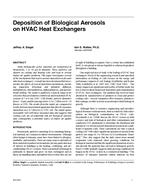
Deposition of Biological Aerosols on HVAC Heat Exchangers
- Comments Off on Deposition of Biological Aerosols on HVAC Heat Exchangers
- ASHRAE
Many biologically active materials are transported as bioaerosols, 1 to 10 µm in diameter. These particles can deposit on cooling and heating coils and lead to serious indoor air quality problems. This paper investigates several of the mechanisms that lead to aerosol deposition on fin-and-tube heat exchangers. A model has been developed that incorporates the effects of several deposition mechanisms, includ-ing impaction, Brownian and turbulent diffusion, turbophoresis, thermophoresis, diffusiophoresis, and gravitational settling. The model is applied to a typical range of air velocities that are found in commercial and residential HVAC systems of 1 to 6 m/s (200 – 1200 ft/min), particle diameters from 1 – 8 µm, and fin spacings from 3.2 to 7.9 fins/cm (8 – 16 fins/in. or FPI). The results from the model are compared to results from an experimental apparatus that directly measures deposition on a 4.7 fins/cm (12 FPI) coil. The model agrees reasonably well with these measured data and suggests that cooling coils are an important sink for biological aerosols and, consequently, a potential source of indoor air quality problems.
Authors:Jeffrey A. Siegel, Iain S. Walker, Ph.D.
Citation:Indoor Air Quality 2001 Moisture, Microbes, and Heath Effects: Indoor Air Quality and Moisture in Buildings Conference Papers
Keywords:November, California, 2001, IAQ
Citation: IAQ Conference: IAQ 2001
Product Details
- Published:
- 2001
- File Size:
- 1 file , 150 KB
- Product Code(s):
- D-8154

